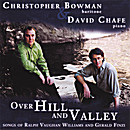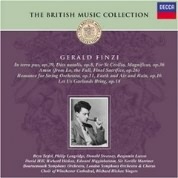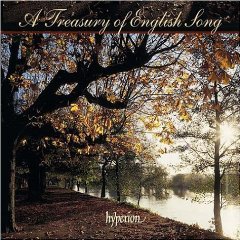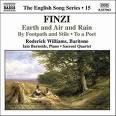The Phantom
Poet: Thomas Hardy
Date of poem: 1913
Publication date: 1914
Publisher:
Collection: Satires of Circumstance
History of Poem:
Poem
The Phantom Horsewoman |
||
|---|---|---|
I |
||
| 1 | Queer are the ways of a man I know: | |
| 2 | He comes and stands | |
| 3 | In a careworn craze, | |
| 4 | And looks at the sands | |
| 5 | And the seaward haze | |
| 6 | With moveless hands | |
| 7 | And face and gaze, | |
| 8 | Then turns to go . . . | |
| 9 | And what does he see when he gazes so? | |
| II | ||
| 10 | They say he sees as an instant thing | |
| 11 | More clear than to-day, | |
| 12 | A sweet soft scene | |
| 13 | That was once in play | |
| 14 | By that briny green; | |
| 15 | Yes, notes alway | |
| 16 | Warm, real, and keen, | |
| 17 | What his back years bring - | |
| 18 | A phantom of his own figuring. | |
| III | ||
| 19 | Of this vision of his they might say more: | |
| 20 | Not only there | |
| 21 | Does he see this sight, | |
| 22 | But everywhere | |
| 23 | In his brain - day, night, | |
| 24 | As if on the air | |
| 25 | It were drawn rose-bright - | |
| 26 | Yea, far from that shore | |
| 27 | Does he carry this vision of heretofore: | |
| IV | ||
| 28 | A ghost-girl-rider. And though, toil-tried, | |
| 29 | He withers daily, | |
| 30 | Time touches her not, | |
| 31 | But she still rides gaily | |
| 32 | In his rapt thought | |
| 33 | On that shagged and shaly | |
| 34 | Atlantic spot, | |
| 35 | And as when first eyed | |
| 36 | Draws rein and sings to the swing of the tide. | |
1913 |
||
(Hardy, 353-4) |
||
Content/Meaning of the Poem:
Speaker:
Setting:
Purpose:
Idea or theme:
Style:
Form:
Synthesis:
Published comments about the poem:
✦✼✦✼✦✼✦✼✦✼✦✼✦✼✦✼✦✼✦✼✦✼✦✼✦✼✦✼✦✼✦✼✦✼✦
✦✼✦✼✦✼✦✼✦✼✦✼✦✼✦✼✦✼✦✼✦✼✦✼✦✼✦✼✦✼✦✼✦✼✦
Musical Analysis
Composition date:
Publication date:
Publisher: Boosey & Hawkes - Distributed by Hal Leonard Corporation
Tonality:
Transposition:
Duration:
Meter:
Tempo:
Form:
Rhythm:
Melody:
Texture:
Vocal Range:
Tessitura:
Dynamic Range:
Accompaniment:
Published comments about the music:
Pedagogical Considerations for Voice Students and Instructors:
✦✼✦✼✦✼✦✼✦✼✦✼✦✼✦✼✦✼✦✼✦✼✦✼✦✼✦✼✦✼✦✼✦✼✦
✦✼✦✼✦✼✦✼✦✼✦✼✦✼✦✼✦✼✦✼✦✼✦✼✦✼✦✼✦✼✦✼✦✼✦
| Pitch Analysis | ||||||
|---|---|---|---|---|---|---|
| pitch | stanza 1 |
stanza 2 |
stanza 3 |
stanza 4 |
total | |
highest |
A |
|||||
G |
||||||
F |
||||||
E |
||||||
D |
||||||
middle C |
||||||
B |
||||||
A |
||||||
G |
||||||
F |
||||||
lowest |
E |
|||||
| Rhythm Duration Analysis of Vocal Line | |||||
|---|---|---|---|---|---|
| stanza 1 | stanza 2 | stanza 3 | stanza 4 | total | |
16th note |
|||||
8th note |
|||||
dotted 8th |
|||||
quarter note |
|||||
dotted quarter |
|||||
triplet |
|||||
half note |
|||||
dotted half |
|||||
stanza total |
|||||
✦✼✦✼✦✼✦✼✦✼✦✼✦✼✦✼✦✼✦✼✦✼✦✼✦✼✦✼✦✼✦✼✦✼✦
Audio Recordings
Over Hill and Valley: Songs of Ralph Vaughan Williams and Gerald Finzi |
|
|
|
The British Music Collection: Gerald Finzi |
|
|
|
Song Recital |
|
|
|
Songs: Brahms - Faure - Finzi - Schubert |
|
|
|
The Songs of Gerald Finzi to Words by Thomas Hardy
|
|
|
|
A Treasury of English Song |
|
|
|
Gerald Finzi |
|
|
|
The English Song Series - 15 |
|
|
|
✦✼✦✼✦✼✦✼✦✼✦✼✦✼✦✼✦✼✦✼✦✼✦✼✦✼✦✼✦✼✦✼✦✼✦
The following is an analysis of The Phantom by Gerhardus Daniël Van der Watt. Dr. Van der Watt extended permission to post this excerpt from his dissertation on October 8th, 2010. His dissertation dated November 1996, is entitled:
The Songs of Gerald Finzi (1901-1956) To Poems by Thomas Hardy
This excerpt comes from Volume II and begins on page 189 and concludes on page 198. To view the methodology used within Dr. Van der Watt's dissertation please refer to: Methodology - Van der Watt.
1. Poet
Specific background concerning poem:
"The Phantom Horsewoman" comes from Satires of Circumstance (1914). Following Emma's death in November 1912, Hardy felt a need to make a pilgrimage to St. Juliot where they met in 1870. a number of poems result from the very painful visit. In a letter to Florence Dugdale, the future Mrs. Hardy, he says: "The visit has been a very painful one to me, & I have said a dozen times I wish I had not come." (Seymour-Smith, 774) Musing about the past and places from the past always prompted Hardy to write poetry. Poems in this particular set include, Places (Plymouth, March 1913); The Phantom Horsewoman (1913), The Spell of the Rose and St. Launce's Revisited.
2. Poem
The Phantom Horsewoman |
||
|---|---|---|
I |
||
| 1 | Queer are the ways of a man I know: | a |
| 2 | He comes and stands | b |
| 3 | In a careworn craze, | c |
| 4 | And looks at the sands | b |
| 5 | And the seaward haze | c |
| 6 | With moveless hands | b |
| 7 | And face and gaze, | c |
| 8 | Then turns to go . . . | a |
| 9 | And what does he see when he gazes so? | a |
| II | ||
| 10 | They say he sees as an instant thing | d |
| 11 | More clear than to-day, | e |
| 12 | A sweet soft scene | f |
| 13 | That was once in play | e |
| 14 | By that briny green; | f |
| 15 | Yes, notes alway | e |
| 16 | Warm, real, and keen, | f |
| 17 | What his back years bring - | d |
| 18 | A phantom of his own figuring. | d |
| III | ||
| 19 | Of this vision of his they might say more: | g |
| 20 | Not only there | h |
| 21 | Does he see this sight, | i |
| 22 | But everywhere | h |
| 23 | In his brain - day, night, | i |
| 24 | As if on the air | h |
| 25 | It were drawn rose-bright - | i |
| 26 | Yea, far from that shore | g |
| 27 | Does he carry this vision of heretofore: | g |
| IV | ||
| 28 | A ghost-girl-rider. And though, toil-tried, | j |
| 29 | He withers daily, | k |
| 30 | Time touches her not, | l |
| 31 | But she still rides gaily | k |
| 32 | In his rapt thought | l |
| 33 | On that shagged and shaly | k |
| 34 | Atlantic spot, | l |
| 35 | And as when first eyed | j |
| 36 | Draws rein and sings to the swing of the tide. | j |
1913 |
||
(Hardy, 353-4) |
||
The poem contains the description of a man tortured by the recurring hallucinatory image of a vibrant young woman riding a horse on the shore of an Atlantic beach. The persona, probably the poet finding it too painful to relate the events in the first person, uses the third person. The man's behavior suggests a fixation with the image in his mind which seems to disturb him to the point of near madness ("careworn craze...he see(s) this sight...everywhere...toil-tride...He withers daily...rapt thought"). The reason for the fixation is not stated explicitly. Contrasting the description of the ageing man, the subject of his fixation is beautiful, unaffected by time, joyous and carefree ("rose bright,...Time touches her not,... rides gaily,...Draws rein and sings...").
There are a number of typically Hardian themes present in the poem:
Age versus Youth
Imaginary images/phantoms/ghosts
Exploration of male psychology
At the relation that this poem has with Hardy's life one can only speculate: Under the circumstances of its conception referred to earlier, Hardy himself is the haunted man, hence the intimate knowledge he has of the image and the man's mental state. The painful remorse he experienced after Emma's death might well have prompted such images, strengthened in the right place at the right time.
The poem is almost in the style of a Gothic ballad although there is no refrain other than the implied recurring image.
The physical form of the poem is quite interesting. There are four nine-line stanzas with the middle seven lines indented and shortened, leaving the outer two lines of each stanza much longer and rhyming. The indented lines contain an intensified description of the man or the image he sees. The longer lines slow down the tempo and thus draw attention to themselves. The rhyme scheme is varied rounded: a bcbcbca a, and is similar in each stanza. There are three types of metre present in the poem: dactylic (l. 1, 9, 10, 27, 36), iambic (l. 6-8), a number of lines with a mixture of these and a few examples of spondaic metre (l. 16, 23, 26, 30, 32).
The meaning of the poem, a psychological exploration of the fixation of a man, is supported by the tone and atmosphere created by the use of language. The lexical set associated with the man's mental state will serve as an example:
queer, careworn craze, moveless hands, gazes, sees...A phantom, this sight, this vision, toil-tried, he withers, rapt thought
This shows Hardy's masterful use of language to assist him in portraying a mental picture of his subjects and events: an ageing man's memory of his youthful beloved haunts him.
Setting
1. Timbre
VOICE TYPE/RANGE
the song is set for baritone and the range is a perfect eleventh from the first C below middle C. The occurrence of four high Fs, makes the song quite challenging for a baritone
The piano accompaniment roughly covers a range of four octaves but the middle and lower registers are favoured. The accompaniment only moves outside the treble clef stave to one ledger line above the stave in seven bars (6%) while the right hand is notated in the bass clef in 20 bars (18%). This favoring of the middle and lower registers is suitable to large sections of the text dealing with a phantom rider and a man's emotional and mental turmoil.
There are no actual pedal indications but sensible pedal use would be a prerequisite for the successful performance of this song. There are extensive longer legato indications but also shorter, more motif-related legato indication (b. 16-19, 47-48, bass 49-56, 99-100). There are some staccato indications, principally on what will be called the rider-motif (b. 1 treble) in bars 4 (bass), 39 (bass) and 110 (bass). This motif will be discussed in more detail later. There are two indications of half-staccatos namely in bars 36 and 38 which reinforces the imitation of the melodic line (b. 35) at that moment.
There are many instances where the piano acts alone or with only a voice pedal note. All these preludes, links, afterthoughts, interludes and a postlude are instrumental in the setting of the mood and atmosphere of the adjacent texts. The function of the piano varies as the story unfolds:
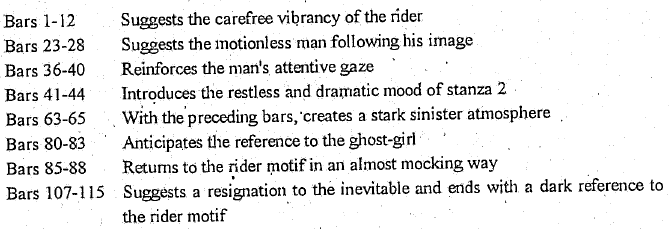
The piano, furthermore, supports while the vocal line is in progress in a most striking way. The man's pathetic state is underlined with chromaticism (b. 88-91) while the defiant rider is portrayed with bold chords, ff dynamics and internal metric changes (b. 97-107).
2. Duration
METRE
The textual metre is a fairly even mixture between dactylic and iambic. The compound duple time signature was taken from the former. Metric variations are given below:

The most prominent metre is the opening compound duple and serves the textual metre and the general atmosphere of the song well. It should be noted that at both metric changes the beat unit stays the same. There are a further three minor metric changes which are internal and indicated by the use of ties. These occur just before and after the main climax for the sake of dramatic emphasis: bars 101, 103 and 105 are momentarily in 3/4.
Rhythmic motifs
the most prominent rhythmic (and melodic) motif is that of the rider referred to earlier. It is to be found in its complete form (including the slight variation of substituting the dots with rests) 11 times and another 13 times with a further variation replacing the second beat with a crotchet and quaver. The second motif that is used amply is the crotchet and quaver which occurs in both piano and voice some 129 times. This motif is largely responsible for the unity that the song possesses but also creates the constant lulling effect associated with the movement of the sea which is an important backdrop to the setting of the poem. The last prominent motif is only found in the second stanza setting (b. 41-58) and consists of a semi-quaver, quaver, semi-quaver and occurs 37 times mostly in the bass. This more hesitant motif supports the references to the "sweet soft scene" which the man is reluctant to relinquish.
Rhythmic activity vs. Rhythmic stagnation
The rhythmic material of the song is fairly active and as a consequence the less active sections will draw attention. Bars 20-29 are quite stagnant but appropriately so since the accompanying text is, "motionless hand and face and gaze". Another very short rhythmic stagnation is found in bar 73, accompanying the spondaic metre of the words, "day, night". In this instance the rhythmic stagnation serves as a means of emphasis of the continuous occurrence of the image in the man's mind. A final, virtual standstill rhythmically, occurs at the piano climax (b. 104) aptly accompanying the words "Draws rein" which is indeed what the piano does at that moment.
Rhythmically perceptive, erroneous and interesting settings
The following words have been perceptively or interestingly dealt with rhythmically:
The only rhythmic weakness is the lengthening of phrase-end words that naturally have short sounds, namely "spot" (b. 99) and also to some extent "gaze" (b. 23), "eyed" (b. 102) and "tide" (b. 107)
Lengthening of voiced consonants
The following words containing voiced consonants have been rhythmically prolonged in order to allow the word to be more singable:

The tempo indication is Allegretto con moto ![]() . A number of deviations from this indication occur and these are listed below:
. A number of deviations from this indication occur and these are listed below:
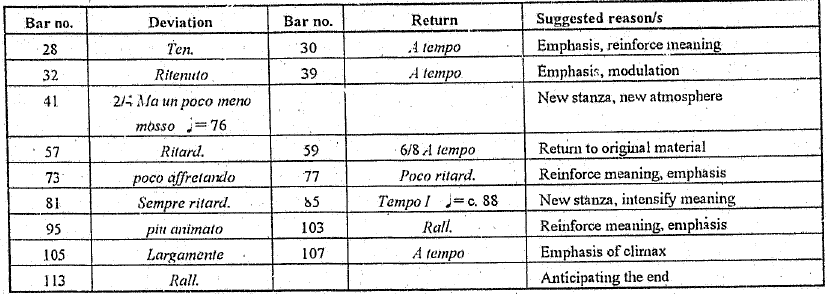
3. Pitch
An interval analysis of the vocal line is represented in the following table:
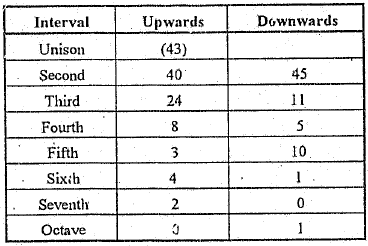
There are 80 rising intervals (41%), 73 falling intervals (37%) and 43 repeated pitches (22%). Smaller intervals (repeated pitches, seconds and thirds) constitute the overwhelming majority of the intervals used (163 or 83%) while intervals of a fourth and larger are only 34 or 17% in number. These last two figures indicate the composer's sympathetic treatment of the voice in this setting. In such a context larger intervals become more important, since the composer has selected to use larger intervals with specific words. A summary is given below:
Specific settings:
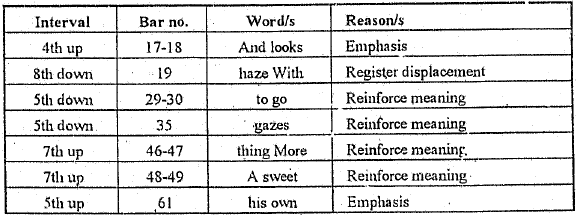

Melodic curve
The melodic curve is given below. Particular words are indicated to show the relationship between the melodic curve and meaning.
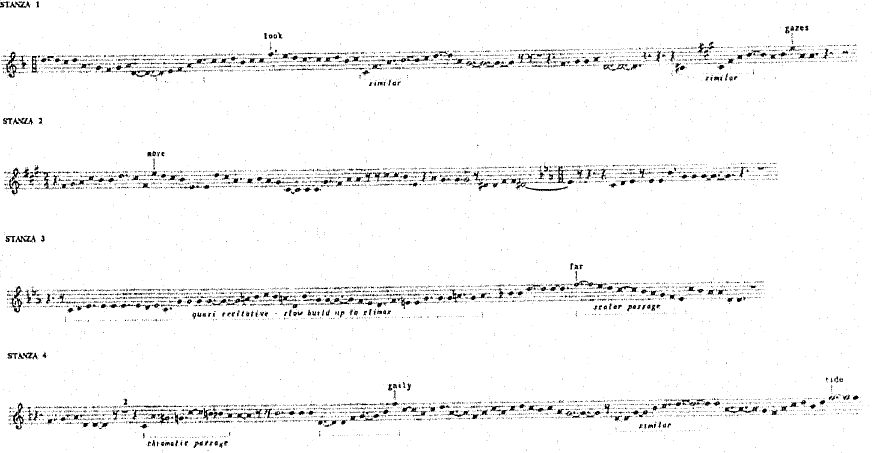
As indicated, there are three moments of similarity in the melodic curve of stanza 1. The respective texts are:
Bars 15-16 "He comes and stands..."
Bars 19-21 "With moveless hands..."
Bars 33-34 "and what does he see..."
These similarities bind the stanzas into a sensible melodic whole. The third stanza has a long, slow upward curve (b. 65-76) to the melodic climax on the word "far". This slow build-up, furthermore, has recitative characteristics and is as such very effective in the dramatic surge towards the climax. Stanza 3 contains a chromatic vocal passage (b. 89-91) which aptly supports the text, "toil-tried/He withers daily". There are also two similar rising lines (vaguely reminiscent of the similar movement in stanza 1) in bars 93-94 and 100-102 (as indicated). These are both related to the meaning of the text at the respective moments.
Climaxes
Primary and secondary climaxes are given below:

There is no single climactic instance, the F recurring four times. All the words given prominence through their melodic placing are in fact important words in their immediate contexts.
Phrase lengths
Phrases are long, especially the first one, (b. 12-25) but are mostly subdivisible to allow for breathing on the part of the singer. It would be advisable to breathe half way through bar 15 to ensure that bars 23-25 will be sustained. These extended final pitches of many phrases are a recurring feature of the song and only careful breathing by the singer will result in successful performance.
The basic key is d minor, though the song starts with an F major section. Key changes are summarized below:
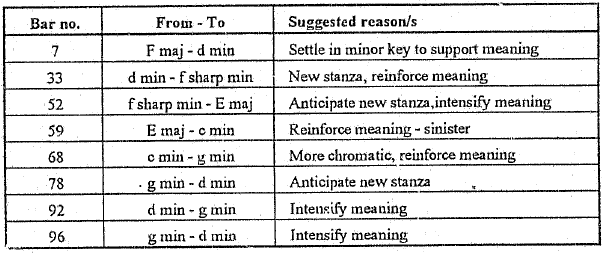
The final number of modulations can also be seen as transitions since the key barely settles before it moves to the next (b. 77, 92, 96)
Chromaticism
There are two significant chromatic passages in the piano part (apart from the one already mentioned):
These chromatic passages support the pathos and inner turmoil.
Modal use:
There is a vague sense of modality in the song due to the occasional appearance of an E-flat into the largely d minor context (b. 92, 94, 102, 110).
HARMONY AND COUNTERPOINT
the harmonic language is largely tonal with chromatic passages as indicated above.
Non-harmonic tones
The most prominent non-harmonic tone in the song is the appoggiatura which occurs to create stronger expressive dissonance on the beat ![]()
Harmonic devices
There are many voice pedal notes which prolong the final note of the phrase so that is overlaps with the continuing piano part. These extended notes in some cases create dissonance:
Bars 23-25, 30-23 (dissonance), 58-59, 99-100 (dissonance), 107-109
The piano also has a number of pedals and these occasionally coincide with the voice:
Bars 4-8, 21-22, 23-25, 26-29, 33-34, 49-50, 66-67
These are relatively few which are in line with the active rhythmic movement of the song, which in turn supports the restlessness of the rider and the man's emotional turmoil.
There are also a number of very interesting chordal constructions in the song. These principally serve as sound accents at important moments:

Counterpoint
There are a number of subtle, imitations between voice and piano:
The piano, internally, contains a number of imitations, usually the rider motif, for creating a sense of incessant movement of the phantom rider and the recurrence of the image in the man's mind. These are listed below:
Bars 1-2 treble - bass, 60-62 bass - treble, 85-87 treble - bass - treble, 92-93 treble-bass, 95-96 treble - bass
Loudness variation is given in the following summary:

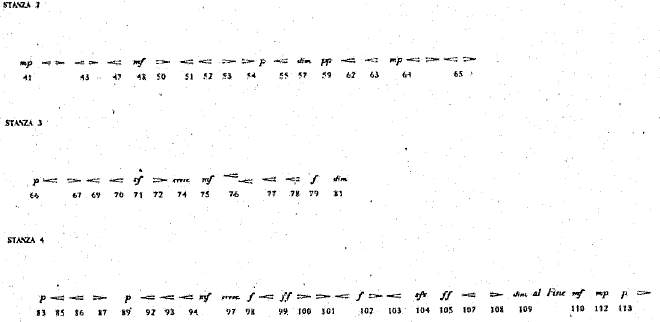
FREQUENCY
There are 91 dynamic indications meaning that 79% of the bars contain indications. There are no separate indications for the voice, implying that the voice must follow the same indications.
RANGE
The highest level indications are sfz and ff both occurring at the pianistic climax in bars 104-105. The lowest level, pp occurs three times: bars 30 and 33 where this level is in sympathy with the man's pathetic state ("Then turns to go") and bar 58 where this level accompanies the reference to the very first mention of the phantom.
VARIETY
the indications used are:
DYNAMIC ACCENTS

The density varies loosely between a single note on the piano and nine parts including voice and piano. The thickness of the piano part is represented in the following table:
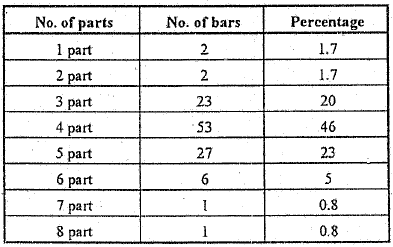
The four-part thickness dominates substantially and between the three- and six-parts textures 94% of the bars are accounted for. With the four- and five-parts dominating, it is important to consider why four bars contain only a single note or two. The two single notes occur in similar contexts but at the two extremes of the song (b. 5 and 111). In each case the texture thins out just prior to a three-part texture and the single note has a portamento accent. The implication is that all the music focuses on a single pitch much as the man fixes on the single image of the rider to the exclusion of everything else. The two bars with a two-parts piano texture occur with the words, "More clear than today" (b. 47-48) and this transparent texture aptly accompanies the idea of clarity in the text.
The structure of the song can be represented in the following table:

The C section or third stanza contains elements from the A section but these are not strong enough to class it as A1. the A section contains three short piano links: bars 23-27, (related to the gazing man) 30-33 (resuming activity once the man has left) and 36-40 (reinforcing what the man gazes at). The formal structure of the song is a variation on the through-composed type, with a definite reference to the opening material in the postlude.
7. Mood and atmosphere
This ballad concerns a man's vision of a young woman on horseback which tortures him with her youth, liveliness and phantasmic appeal. The piano prelude suggests her wild riding and there is a sense of the image coming and going as the man's mind creates and rejects. The accompaniment settles in d minor so that the bulk of information concerning the man's state of mind ("careworn craze") can be related. The piano accompaniment slows down at, "moveless hands and face and gaze" but very soon the riding motif starts up again. The riding motif interjects, punctuated with staccatos, to make it more conspicuous and mocking. The short interlude preceding stanza 2 is of a restless, dramatic character. A very sinister atmosphere is created by the low parallel fifth chords prior to the first mention of the phantom. Chromaticism in conjunction with the text, "Does he see this sight", creates a troubled atmosphere to reinforce the man's state of mind. More chromaticism evokes a sympathetic pathos when the text refers to the man as "toil-tried" and withering. The piano accompaniment suggests defiance on the part of the rider leading up to the climax in bars 104-105. The atmosphere becomes resigned and ethereal in the postludes if the image is finally fading into nothing.
General comment on style
The song exhibits a dissonant style, still tonally contained. The vocal line is very well cared for and treated sympathetically; the musical material never forces the voice to be used in a unnatural way. The upper register of the piano is avoided in favour of creating a suitably dark and sinister atmosphere. All musical elements meticulously serve the meaning of the text.
Unpublished Analysis Excerpts
The following is an analysis of The Phantom by Curtis Alan Scheib. Dr. Scheib extended permission to post this excerpt from his dissertation on February 17th, 2012. His dissertation dated 1999, is entitled:
Gerald Finzi's Songs For Baritone On Texts By Thomas Hardy: An Historical And Literary Analysis And Its Effect On Their Interpretation
This excerpt begins on page forty and concludes on page forty-two.
The Phantom Horsewoman |
||
|---|---|---|
I |
||
| Queer are the ways of a man I know: | ||
| He comes and stands | ||
| In a careworn craze, | ||
| And looks at the sands | ||
| And the seaward haze | ||
| With moveless hands | ||
| And face and gaze, | ||
| Then turns to go . . . | ||
| And what does he see when he gazes so? | ||
| II | ||
| They say he sees as an instant thing | ||
| More clear than to-day, | ||
| A sweet soft scene | ||
| That was once in play | ||
| By that briny green; | ||
| Yes, notes alway | ||
| Warm, real, and keen, | ||
| What his back years bring - | ||
| A phantom of his own figuring. | ||
| III | ||
| Of this vision of his they might say more: | ||
| Not only there | ||
| Does he see this sight, | ||
| But everywhere | ||
| In his brain - day, night, | ||
| As if on the air | ||
| It were drawn rose-bright - | ||
| Yea, far from that shore | ||
| Does he carry this vision of heretofore: | ||
| IV | ||
| A ghost-girl-rider. And though, toil-tried, | ||
| He withers daily, | ||
| Time touches her not, | ||
| But she still rides gaily | ||
| In his rapt thought | ||
| On that shagged and shaly | ||
| Atlantic spot, | ||
| And as when first eyed | ||
| Draws rein and sings to the swing of the tide. | ||
1913 |
||
(Hardy, 353-4) |
||
The poem is one of the remorseful ones Hardy composed after the death of Emma. His memory of her, here the ghostly rider, is ever present and ever young, while he withers in the firm grasp of time. Finzi's setting, dated 1932, is one of his finest. His use of the triadic motive in the accompaniment (example 7), reminiscent of the techniques of the German Lied composers, serves both to propel the musical forward, and to symbolize the ride of the ghostly memory.
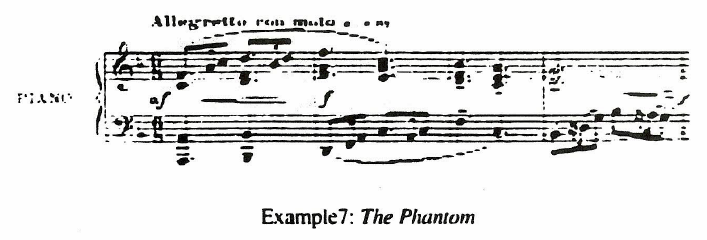
The figure is heard frequently, and in one last musical recollection (example 8), reappears at the end.
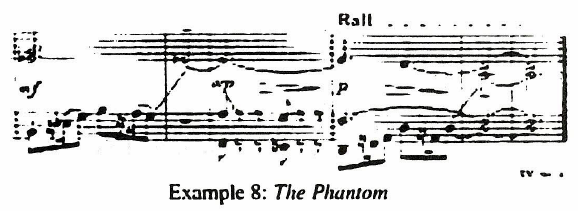
The accompaniment throughout is full of expressive touches, painting changes of thought and focus in an almost operatic manner. The slowing and suspension of the galloping figure after "With moveless hands and face and gaze" which leaves the listener suspended momentarily, only to return with "Then turns to go," is but one example. Another striking one comes soon after, as the poet asks "And what does he see he gazes so?" Here Finzi, as does Hardy, suspends time momentarily, then alters the triadic motive from the beginning to a syncopated figure in the bass. There is also here a slowing of the pace to accompany the more introspective feel of the text. The repose is momentary however as the phantom soon returns with her triadic figure restored. Finzi makes use of chromatic harmony here much more than in his earlier songs. There is also a good deal of minor inflection throughout, the major-minor struggle coinciding with the poet's own struggle with the omnipresent memory. The triumphant last "and swing to the swing of the tide" (example 9) is a final example of this ambiguity, the vocal line climaxing in F Major, with the final echo in the piano appearing in d minor to indicate the troublesome reality of the vision.

The preceding was an analysis of The Phantom by Curtis Alan Scheib. Dr. Scheib extended permission to post this excerpt from his dissertation on February 17th, 2012. His dissertation dated 1999, is entitled:
Gerald Finzi's Songs For Baritone On Texts By Thomas Hardy: An Historical And Literary Analysis And Its Effect On Their Interpretation
The excerpt began on page forty and concluded on page forty-two.

